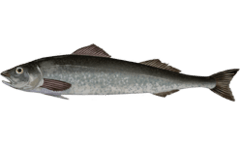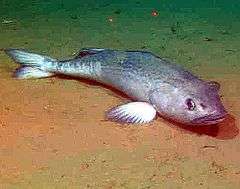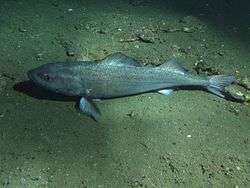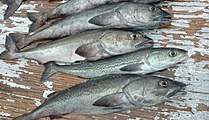Sablefish
| Sablefish | |
|---|---|
 | |
| Anoplopoma fimbria | |
 | |
| Scientific classification | |
| Kingdom: | Animalia |
| Phylum: | Chordata |
| Class: | Actinopterygii |
| Order: | Scorpaeniformes |
| Family: | Anoplopomatidae |
| Genus: | Anoplopoma Ayres, 1859 |
| Species: | A. fimbria |
| Binomial name | |
| Anoplopoma fimbria (Pallas, 1814) | |
The sablefish (Anoplopoma fimbria) is one of two members of the fish family Anoplopomatidae and the only species in the genus Anoplopoma.[1] In English, common names for it include sable (USA), butterfish (USA), black cod (USA, UK, Canada), blue cod (UK), bluefish (UK), candlefish (UK), coal cod (UK), coalfish (Canada), beshow, and skil(fish) (Canada), although many of these names also refer to other, unrelated, species.[2] In the US, the FDA accepts only "sablefish" as the Acceptable Market Name; "black cod" is considered a vernacular (regional) name and should not be used as a Statement of Identity for this species.[3] The sablefish is found in muddy sea beds in the North Pacific at depths of 300 to 2,700 m (980 to 8,860 ft) and is commercially important to Japan.
Ecology
The sablefish is a species of deep-sea fish common to the North Pacific Ocean.[4] Adult sablefish are opportunistic feeders, preying on fish (including Alaskan pollock, eulachon, capelin, herring, sandlance, and Pacific cod), squid, euphausiids, and jellyfish.[5] Sablefish are long-lived, with a maximum recorded age of 94 years,but in recent times they have been undergoing a crisis where numbers have drastically fallen.[6] although the majority of the commercial catch in many areas is less than 20 years old.[7][8]
Tagging studies have indicated that sablefish have been observed to move as much as 2000 km before recapture[9] with one study estimating an average distance between release and recapture of 602 km, with an average annual movement of 191 km.[10]
 Sablefish resting on soft sediment 991 feet deep
Sablefish resting on soft sediment 991 feet deep Small sablefish caught in a bottom trawl survey off the coast of California
Small sablefish caught in a bottom trawl survey off the coast of California
Fisheries
Sablefish are typically caught in bottom traw, longline and pot fisheries. In the Northeast Pacific, sablefish fisheries are managed separately in Alaska, British Columbia, and the U.S. west coast (Washington, Oregon, and California). In all these areas catches peaked in the 1970s and 80s and have been lower since that time due to a combination of reduced populations and management restrictions.[7][11][8] The sablefish longline fishery in Alaska is currently certified as sustainable by the Marine Stewardship Council[12] as is the U.S. West Coast limited entry groundfish trawl fishery which includes sablefish.[13]
Longline fisheries in Alaska frequently experience predation of sablefish by killer whales and sperm whales which remove the fish from the hooks during the process of retrieving the gear.[14][15][16]
As food
The white flesh of the sablefish is soft-textured and mildly flavored. It is considered a delicacy in many countries. When cooked, its flaky texture is similar to Patagonian toothfish (Chilean sea bass). The meat has a high fat content and can be prepared in many ways, including grilling, smoking, or frying, or served as sushi. Sablefish flesh is high in long-chain omega-3 fatty acids, EPA, and DHA. It contains about as much as wild salmon.[17]
Its flesh contains about 0.4ppm of mercury on average, which is considered a high level,[18] comparable to bluefish, albacore tuna, or Chilean sea bass.[19] For that reason, the U.S. FDA recommends that young children and women of childbearing age consume no more than one serving per week (a serving size is about 4 ounces uncooked for an adult, 2 ounces for children ages 4–7 years, 3 ounces for children ages 8–10 years and 4 ounces for children 11 years and older).[20][21]
References
- ↑ Froese, Rainer and Pauly, Daniel, eds. (2005). "Anoplopoma fimbria" in FishBase. 10 2005 version.
- ↑ "Common Names List - Anoplopoma fimbria". Fishbase.org. Retrieved 12 October 2017.
- ↑ "Archived copy". Archived from the original on 17 July 2010. Retrieved 17 July 2010.
- ↑ "Anoplopoma fimbria". Integrated Taxonomic Information System. Retrieved 24 January 2006.
- ↑ Yang, M-S and M. W. Nelson 2000. Food habits of the commercially important groundfishes in the Gulf of Alaska in 1990, 1993, and 1996. NOAA Technical Memorandum NMFS-AFSC-112. 174 p.
- ↑ Kimura, Daniel K., A. M. Shaw and F. R. Shaw 1998. Stock Structure and movement of tagged sablefish, Anoplopoma fimbria, in offshore northeast Pacific waters and the effects of El Nino-Southern Oscillation on migration and growth. Fish. Bull. 96:462-481.
- 1 2 Hanselman DH, Rodgveller CJ, Lunsford CR, Fenske, KH (2017), Assessment of the Sablefish stock in Alaska in: Stock assessment and fishery evaluation report for the groundfish resources of the GOA and BS/AI (PDF), North Pacific Fishery Management Council, 605 W 4th Ave., Suite 306 Anchorage, AK 99501, USA, pp. 307–412.
- 1 2 Johnson KF, Rudd MB, Pons M, Allen C, Lee Q, Hurtado-Ferro F, Haltuch MA, Hamel OS (2016), Status of the U.S. sablefish resource in 2015 (PDF), Pacific Fisheries Management Council, Portland, OR, U.S.A.
- ↑ Beamish, R. J.; McFarlane, C. A. (1988). "Resident and Dispersal Behavior of Adult Sablefish (Anaplopoma fimbria) in the Slope Waters off Canada's West Coast". Canadian Journal of Fisheries and Aquatic Sciences. 45 (1): 152–164. doi:10.1139/f88-017. ISSN 0706-652X.
- ↑ Hanselman, Dana H.; Heifetz, Jonathan; Echave, Katy B.; Dressel, Sherri C. (2015). "Move it or lose it: movement and mortality of sablefish tagged in Alaska". Canadian Journal of Fisheries and Aquatic Sciences. 72 (2): 238–251. doi:10.1139/cjfas-2014-0251. ISSN 0706-652X.
- ↑ DFO (2016), A revised operating model for sablefish (Anoplopoma fimbria) in British Columbia, Canada (PDF), DFO Can. Sci. Advis. Sec. Sci. Advis. Rep. 2016/015
- ↑ "US North Pacific sablefish - MSC Fisheries". fisheries.msc.org. Retrieved 2018-08-23.
- ↑ "US West Coast limited entry groundfish trawl - MSC Fisheries".
- ↑ Peterson, Megan J.; Carothers, Courtney (2013-11-01). "Whale interactions with Alaskan sablefish and Pacific halibut fisheries: Surveying fishermen perception, changing fishing practices and mitigation". Marine Policy. 42: 315–324. doi:10.1016/j.marpol.2013.04.001. ISSN 0308-597X.
- ↑ Sigler, Michael F.; Lunsford, Chris R.; Straley, Janice M.; Liddle, Joseph B. (2008). "Sperm whale depredation of sablefish longline gear in the northeast Pacific Ocean". Marine Mammal Science. 24 (1): 16–27. doi:10.1111/j.1748-7692.2007.00149.x. ISSN 0824-0469.
- ↑ BBC (2015-02-03), Sperm whales steal from a fishing boat - Alaska: Earth's Frozen Kingdom - Episode 1 - BBC Two, retrieved 2018-08-24
- ↑ "Sablefish Anoplopoma fimbria". FishWatch. Retrieved 23 March 2018.
- ↑ "Mercury and selenium levels in 19 species of saltwater fish from New Jersey as a function of species, size, and season". Science of the Total Environment, Volume 409, Issue 8, 15 March 2011, Pages 1418-1429.
- ↑ "Mercury Levels in Commercial Fish and Shellfish (1990-2012)". FDA. Retrieved 13 August 2018.
- ↑ U.S. Food & Drug Administration, "Eating Fish: What Pregnant Women and Parents Should Know"
- ↑ U.S. Food & Drug Administration, "Questions & Answers from the FDA/EPA Advice on What Pregnant Women and Parents Should Know about Eating Fish"
External links
- Alaskan sablefish stock assessment
- Sablefish on the NOAA FishWatch site
- Canadian Sablefish Association
- Sablefish NOAA FishWatch. Retrieved 7 November 2012.